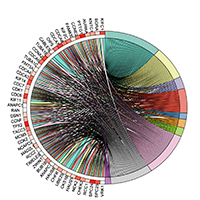The clinical significance of UBE2C gene in progression of renal cell carcinoma

Accepted: 10 February 2021
HTML: 10
All claims expressed in this article are solely those of the authors and do not necessarily represent those of their affiliated organizations, or those of the publisher, the editors and the reviewers. Any product that may be evaluated in this article or claim that may be made by its manufacturer is not guaranteed or endorsed by the publisher.
Authors
Renal cell carcinoma (RCC), with high morbidity and mortality, is one of the top ten serious cancers. Due to limited therapies and little knowledge about the mechanism underlying RCC, overall survival of RCC patients is poor. UBE2C is a member of ubiquitin modification system and promotes carcinogenesis in cancer, but its role in RCC is unknown. Based on the TCGA (The Cancer Genome Atlas) data, UBE2C was over-expressed in a total of 525 RCC tissues and displayed higher expression in advanced tissues (stage IV vs stage I, p<0.05). RT-qPCR and IHC analysis confirmed over-expression of UBE2C in 90 of clinical RCC tissues. Further, UBE2C was associated with clinical factors including TNM stage, gender, and pathological stage. And higher UBE2C expression predicted shorter overall survival and progression-free survival. Both univariate and multivariate COX analysis suggested UBE2C as a critical gene in RCC. Then GO and KEGG analysis showed that cell cycle and DNA replication pathways were two top signaling pathways affected by UBE2C. In vitro assay showed that knockdown of UBE2C in 786-O cells inhibited proliferation and migration significantly. Therefore, this study proves that UBE2C is an important gene in RCC and is essential to proliferation and migration of RCC.
How to Cite
PAGEPress has chosen to apply the Creative Commons Attribution NonCommercial 4.0 International License (CC BY-NC 4.0) to all manuscripts to be published.

 https://doi.org/10.4081/ejh.2021.3196
https://doi.org/10.4081/ejh.2021.3196






